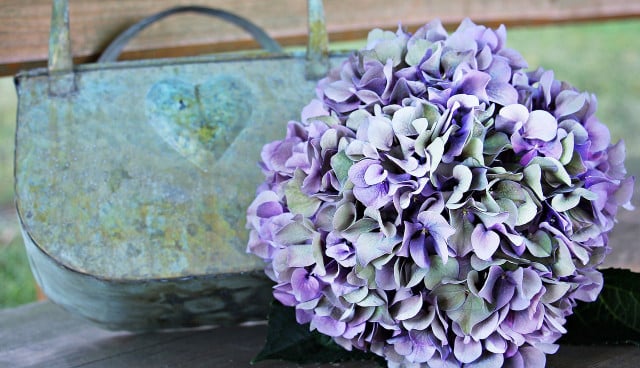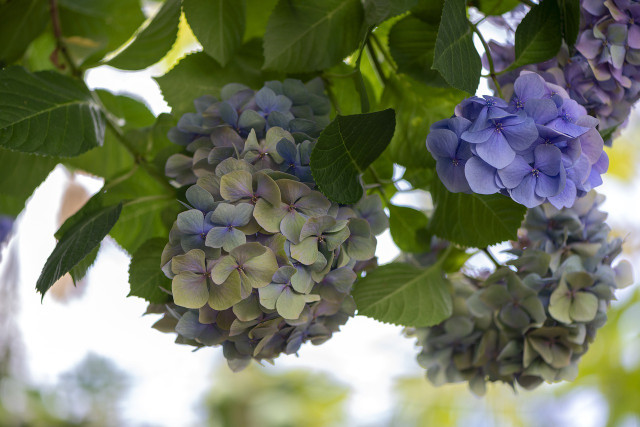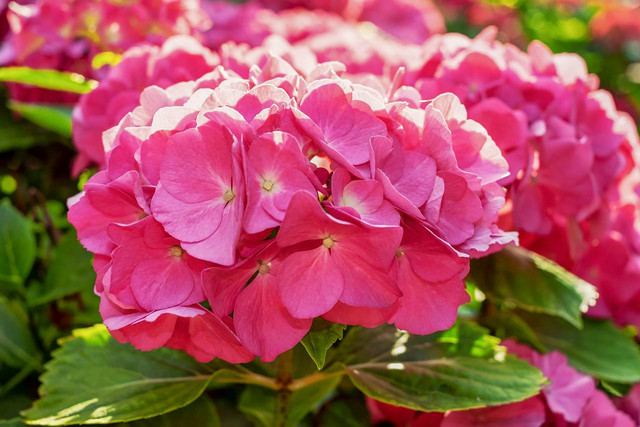These beautiful bushes feel at home in moist soil, but overwatered hydrangeas can quickly take a turn for the worse. Learn how to identify and fix the problem.
The hydrangea is a flowering plant native to eastern Asia and parts of the Americas. There are over seventy-five different hydrangea species, making it a very diverse plant. It blooms in white, blue, red and pink, and can even change colors over the course of its life cycle.
Hydrangeas are a popular, and universally loved house plant. They are typically planted in outdoor gardens, but can be kept as indoor plants as well. They do well in direct sunlight and moist soil, and need lots of water especially in the summer. Still, it is possible to overwater a hydrangea plant.
Signs of an Overwatered Hydrangea

(Foto: CC0 / Pixabay / pixel2013)
Due to the big and bushy blooms, spotting the signs of an overwatered hydrangea can be easy. Here’s what to look for:
- Leaf discoloration: hydrangea laves typically become yellow and brown when overwatered. However, the discoloration can also be a sign of underwatering. Usually, when the plant is overwatered, the browning occurs on the edges of the leaves. You can also refer to the texture of the leaves to figure out what the problem is.
- Wilting or mushy leaves: overwatered hydrangea leaves are heavy and drooping. They may be mushy or pulpy to the touch because their cells are flooded. Underwatered plants, on the other hand, will have dry and crispy leaves.
- Droopy, limp and falling leaves: the plant may be dropping its leaves as plant cells burst due to too much water, and they lose strength. In contrast to underwatered foliage loss, both old and new leaves fall when the plant is overwatered. They will first be drooping, and then they fall off at the stem.
- Stunted growth: if you notice your hydrangea seems to be growing more slowly, or not growing at all, this could be due to overwatering. Mold infestation and root rot could be the cause.
- Mold: fungal growth is only possible in a consistently wet environment, so if your hydrangea’s soil has mold, the plant has definitely been getting too much water. Mold will usually grown on top of the soil and it can look like a white, powdery substance or similar to algae. You can always fix moldy soil, however.
- Root rot: root rot is difficult to diagnose without uprooting the plant and examining the roots. However, all the above signs of overwatering are also signs of root rot. You may be more inclined to think you’re dealing with root rot if your plant’s soil has a foul odor. If you do examine the roots and find them to be brown, wet and mushy, the roots are indeed rotting.
How to Revive Your Overwatered Hydrangea



(Foto: CC0 / Pixabay / stanbalik)
If you have been overwatering your hydrangea plant, don’t worry. You can remedy this using a combination of the steps below:
- Carefully remove the plant from the pot and brush away excess soil.
- Determine whether the soil is moldy, wet, mushy or has a foul odor. If any of these factors apply, you should dispose of the soil.
- Check the roots for any signs of root rot. Healthy roots should be strong and beige or white in color. If the roots appear to be darkened and mushy, they are rotting.
- If the soil and plant roots both appear to be in good condition, you have caught the problem early. In this case, you can simply return the plant back to its pot and leave it to dry out over the next several days. Poke some holes into the soil to help the plant get needed fresh air.
- If the roots are rotting, they need to be pruned. Using sterilized scissors, carefully cut off the rotten roots, leaving only strong and healthy roots remaining.
- Remove damaged leaves as well. Help your hydrangea reserve its energy by cutting away discolored, drooping and mushy leaves.
- Place the plant in a warm, shady spot for at least fifteen minutes. This will help it dry out a bit before repotting.
- Repot the hydrangea in a clean pot with fresh soil. Make sure to use a pot with plenty of drainage holes.
- Thoroughly water the plant. Hydrangeas are more prone to transplant shock, so they must be watered immediately after repotting to prevent this. Soak the soil and then leave the plant alone to recover.
Caring for Hydrangeas



(Foto: CC0 / Pixabay / Couleur)
Like all plants, hydrangeas require specific care in order to thrive. We’ve gathered some tips to help you make the most of your blooming bush.
- Place your hydrangea in morning sun and afternoon shade. These are ideal conditions for hydrangea plants, as they love direct sunlight, but the afternoon rays are too strong for them. If you do not have a suitable spot with these conditions, you can also place your hydrangea in indirect sunlight.
- Provide ventilation. This is crucial to preventing damage from overwatering. Hydrangeas need pots with plenty of drainage holes so that excess water can escape. If the hydrangea is an indoor plant, make sure to open your windows every day and provide fresh air as well.
- Water in the mornings. Hydrangeas enjoy AM watering sessions as it makes it easier to evaporate excess moisture over the course of the day. It also helps them stay cooler in hot temperatures. Make sure to stick to this schedule as your plant will become accustomed to the watering routine.
- Water two to three times per week. Hydrangeas need a good amount of water. If they have a good drainage system in place, it will be harder to overwater them when sticking to the schedule. Typically, you can water your hydrangea twice a week in colder seasons, and three times a week when it gets hot out. Check if your plant needs watering by sticking your finger in the top two inches of soil. Only water if it is dry.
- Practice deep watering. Thoroughly soak the soil when you water your hydrangea. Make sure to water the plant all the way around the pot, but avoid watering the leaves and flowers of the plant. Focus only on the soil, as the plant foliage can also soak up water, and this can lead to overwatering damage.
Read more:
- Keep Your Houseplants Alive: 10 Tips for Healthy Indoor Plants
- Overwatered Pothos: Telltale Signs & Easy Solutions
- Propagating Succulents from Leaves and Cuttings in 6 Easy Steps
Do you like this post?






